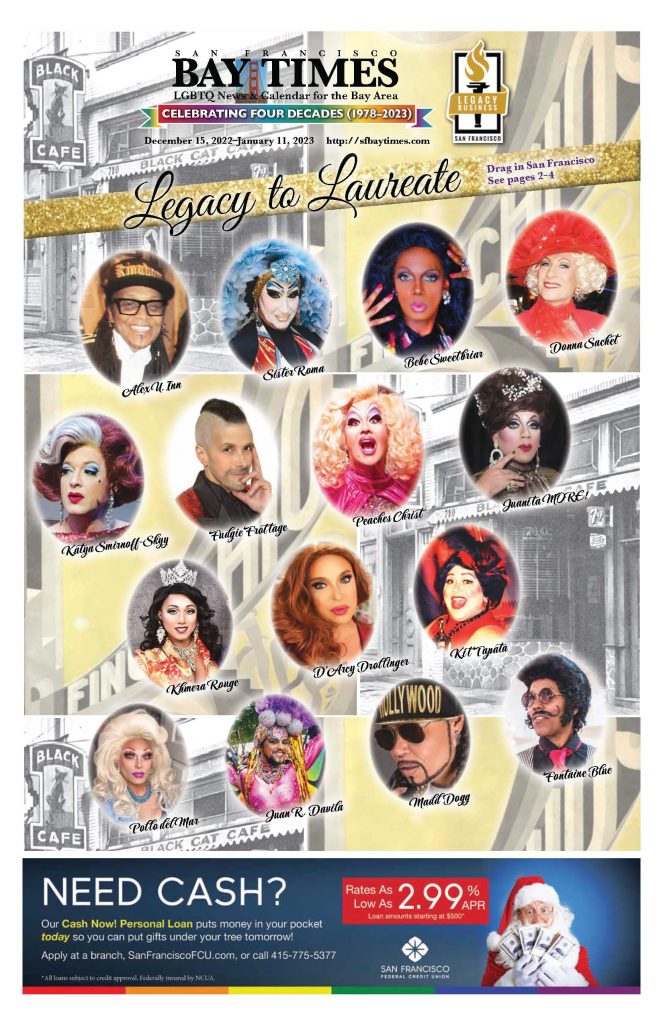
San Francisco has long been a drag mecca. The stage was particularly set for men to use gender expression in performance due, in large part, to their prevalence in the city by the bay. Consider that when the pueblo of Yerba Buena officially was named San Francisco on January 26, 1847, the area’s total population at the time was said to be about 500 people: 321 men and 138 women. Two years later, the population jumped to 20,000, largely fueled by the Gold Rush in California that started on January 24, 1848. Some 40,000 immigrants arrived by ship in 1849; 700 were women and the rest were men.
While nearly all were seeking their fortunes, some were queer men looking for the companionship of other men. Added to that was the region’s already existing reputation for sexual exploits, a certain amount of lawlessness, and thirst for entertainment. Much of this hotbed of activity was centered around the Barbary Coast, a red-light district consisting of a nine-block area featuring dance halls, concert saloons, bars, jazz clubs, variety shows, and brothels. Sailors first coined the Barbary Coast term in the 1860s. The district included a three-block stretch of Pacific Street, now Pacific Avenue, between Montgomery and Stockton Streets. Pacific Street was the first street to cut through the hills of San Francisco, starting near Portsmouth Square and continuing east to the first shipping docks at Buena Vista Cove.

While queer culture already percolated throughout the city and especially in the Barbary Coast district, it came more to the forefront after Prohibition was repealed in 1933. Market Street, Chinatown, the waterfront area, theater district, and additional places became destinations for LGBTQ cultures and communities. It was within such a backdrop that the ambitious Joseph “Joe” Finocchio opened his namesake Finocchio’s Club in 1936.
Finocchio’s
“The most interesting women are not women at all,” reads an early promotional pamphlet for Finocchio’s Club. “They are Finocchio’s accomplished female impersonators. That is why the show at Finocchio’s is always ‘tops’ in entertainment. At Finocchio’s you will see Woman—that miracle of divine contradictions—in all her prismatic gyrations. Woman … whose step is music, whose voice is song. Woman … whom Victor Hugo called ‘the enigma of the nineteenth century,’ whom Confucius called a Masterpiece, whom Tennyson called the lesser man, whom Crowley called ‘one of Nature’s agreeable blunders.'”
The now obvious misogyny was sometimes reflected in the drag shows at Finocchio’s—as it is sadly in some of today’s performances—but the more thoughtful and dedicated artists infused their work with much more than parody and impersonation.

Some early drag stars at Finocchio’s were Li-Kar, who also designed beautiful, elaborate costumes and sets; Frank Doran, who had previously been a headliner on the Orpheum Circuit; Niles Marsh, who was a child prodigy with a remarkable soprano voice; Johnny Mangum, who was discovered by film star Mae West; Del LeRoy, who—disguised in drag—won a beauty contest for “most beautiful legs” and was the only male contestant; Freddie Renault, a comic who was one of Finocchio’s primary producers; Milton La Maire, a specialist in “South Sea Island native dancing”; Ray Francis, who began his life on the stage at age 12 at the old Empress Theatre on Market Street (later the St. Francis); John Lonas, who was so feminine that he was always cast in women’s roles during his long theatrical career; Jackie Maye, who was previously a member of the boys’ chorus at the Metropolitan Opera and had a strong operatic voice and corresponding diva looks; and Karyl Norman, aka “The Creole Fashion Plate.”
Given this cavalcade of drag artists, with many others not named here, and Finocchio’s memorable production numbers, the club became a catalyst for the art of drag. It closed in 1999, with its 63-year-run being one of the most successful for a club in San Francisco history. At least one of its stars, Holotta Tymes, is still actively performing to this day.

‘I Became the Black Cat’
A frequent patron of Finocchio’s was José Sarria. Born in San Francisco in 1922, Sarria stood just under 5 feet tall yet was determined to join the military following the attack on Pearl Harbor. Following his miliary service, Sarria returned to San Francisco, enrolled in college, and planned to become a teacher. He had always enjoyed dressing in women’s clothing, something that even his family supported when he was a young boy. Because of this, and his already burgeoning queer life, he and his sister Teresa began to frequent not only Finocchio’s but also the Black Cat Bar (also called the Black Cat Café).
The Black Cat first opened in 1906 and by 1911 had become known for its vaudeville-style acts. It closed in 1921, but re-opened in 1933 at 710 Montgomery Street under the proprietorship of Charles Ridley. An entrepreneur named Sol Stoumen purchased the bar in the 1940s, and it was under his ownership that it gained, first, a Beat and bohemian clientele, and then, after World War II, a largely LGBTQ following. The gay Beat poet Allen Ginsberg described the Black Cat as “the best gay bar in America. It was totally open, bohemian, San Francisco … and everybody went there, heterosexual and homosexual … . All the gay screaming queens would come, the heterosexual gray flannel suit types, longshoremen. All the poets went there.”
And Sarria was there as well, eventually being hired after the owners and staff heard him sing. He had a tenor voice and could reach high C even just while speaking. Since he took tap and ballet classes as a child, he could incorporate some impressive dance moves into his performances.
He later shared with Nan Alamilla Boyd, the author of Wide Open Town: A History of Queer San Francisco to 1965: “To work at the Black Cat, I had to be a little bit different, so I’d put on a little bit of makeup. Short hair was in style for women, not long hair, and I would dress in basic black and pearls. I wore men’s slacks, a leotard type of top, and I would borrow my mother’s earrings. They all were legitimate things. My mother always said if you’re going to wear jewelry, make sure it’s good. My eyebrows were plucked in those days. I didn’t look like a clown—I was neither there nor here. You could say I was a boy, you could say I was a girl. I was unique.”
Sarria added, “I began singing. I also used to cocktail wait, but soon there was no more cocktail waiting. I was the entertainer, and I, whether or not I knew it at the time or whether or not anyone else realized it, I changed the character of the Black Cat. I became the Black Cat.”
Synonymous with the bar, Sarria became known as “the Nightingale of Montgomery Street.” He sang not only popular songs of the time but also parodies of well-known torch songs with a queer twist and full-blown parodic operas in his natural high tenor. In a reworking of Carmen, he sang of prowling through the then-popular cruising area of Union Square. The audience cheered “Carmen” on as she dodged the vice squad and made her escape.
Before the Black Cat’s closure in 1964, Sarria ran for the San Francisco Board of Supervisors in 1961, becoming the first openly gay candidate for public office in the U.S. He later went on to found the Society for Individual Rights that, with the Tavern Guild, helped to advise LGBTQ people on what to do if they were harassed or arrested by the police. He was also crowned Queen of the Beaux Arts Ball in 1964 by the Tavern Guild. This and other balls for decades prior were showcases for drag artists. A year later, in 1965, came one of Sarria’s crowning achievements: the founding of the Imperial Court System.

Imperial and Ducal Courts
Sarria’s influence on drag, not just in San Francisco but the world over, cannot be understated. Through the Imperial Court System— with volunteer members bearing titles of nobility bestowed by yearly elected figurehead leaders of Emperor and Empress—he connected drag to fundraising for LGBTQ and other charitable causes. Through the Imperial Court System alone, millions of dollars have been raised for causes such as the fight against HIV/AIDS, breast cancer, domestic abuse, and homelessness. Over the past half century, the non-profit organization has grown to represent communities in 86 different locations across the U.S., Canada, and Mexico.

It helped to inspire the creation of drag houses, such as those documented in the popular film Paris Is Burning, and the Grand Ducal Council of San Francisco, which was formed in 1973 as a more camp-oriented response to the Imperial Court System. 2023 will mark the Grand Ducal Council’s 50th Anniversary, so the San Francisco Bay Times is now featuring a column by Grand Duke XL Kippy Marks documenting the Council’s own rich history.
Intentionally Outrageous
Preconceived notions about drag were blown away by The Cockettes, an avant garde psychedelic hippie theater group founded by Hibiscus (George Edgerly Harris III) in 1969. While the group, like Sarria, at first focused on parodies, they later became known for their all-original and often-outrageous staged performances frequently featuring men wearing glitter in their beards and exaggerated eye make-up. Divine, later made famous in films by John Waters, was a notable Cockette. In one show, Divine sang, “If there’s a crab on Uranus you know you’ve been loved” while dressed as a psychedelic crab queen.
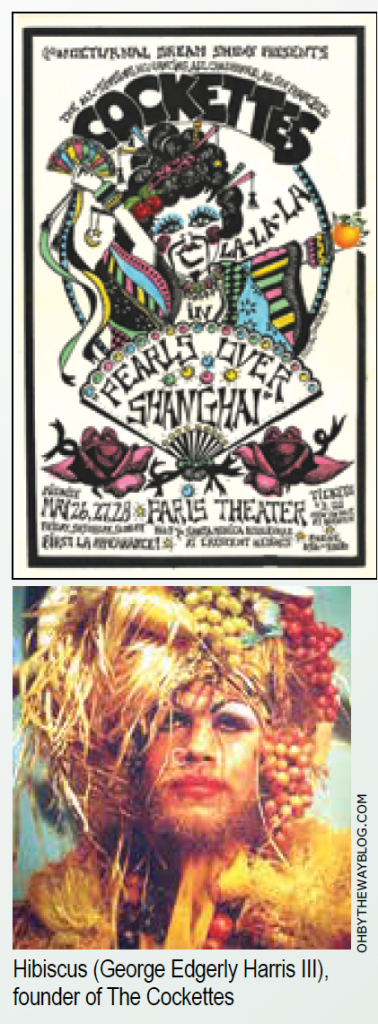
While not exclusively focused on drag, The Cockettes’ shows often included drag queens as well as drag kings, who are mostly female performance artists who dress in masculine drag and personify male gender stereotypes. Bioqueens—biologically female performance artists who perform in female drag—were also embraced by The Cockettes, as was racial diversity. Sylvester was one of The Cockettes’ earliest stars before he became a disco legend. Sylvester’s rendition of torch songs by the likes of Etta James, Shirley Bassey, Billie Holiday, and Lena Horne foreshadowed his becoming a prolific singer of international acclaim.
The Sisters of Perpetual Indulgence, founded in 1979, has the camp of the Ducal Court and the outrageousness of The Cockettes within its unique mix. The charity, protest, and street performance organization uses drag and religious imagery to call attention to sexual intolerance and satirizes issues of gender and morality. Prominent members today include Sister Roma and long-time San Francisco Bay Times columnist Sister Dana Van Iquity. The Sisters of Perpetual Indulgence remains one of the most successful drag-centric nonprofits in the city, with Sisters now in other U.S. cities, Canada, Australia, Europe, and South America.
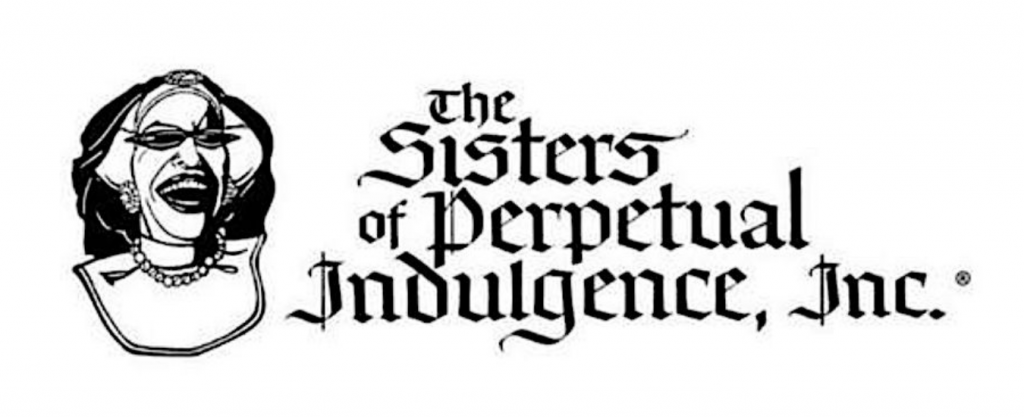
Marlena’s
As the LGBTQ community grew in prominence from the 1970s onwards, so too did drag in shows throughout the city. No longer relegated to a red-light district, drag artists were, and are, featured in shows targeting both locals as well as tourists. For many visitors to San Francisco, drag is an iconic if not still a bit racy aspect of the city that they wish to experience along with that hunk of sourdough bread and a drive over the Golden Gate Bridge.
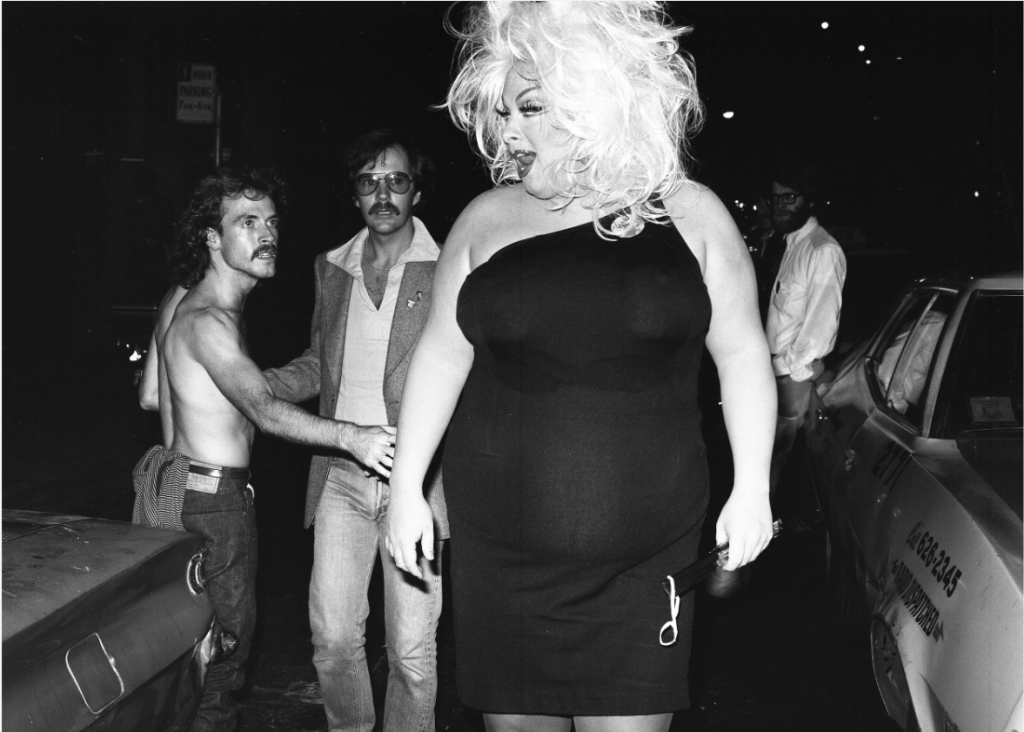
In 1990, drag artist Garry “Marlena” McClain took over what would become Marlena’s Bar at 488 Hayes Street in the heart of Hayes Valley. For the next 23 years, he turned it into the city’s premiere drag establishment. The neighborhood at the time of McClain’s acquisition was one of the roughest in the city, positioned drearily near the Central Freeway overpass on Octavia Street. McClain told Hoodline: “[When I bought it] it was a little bar in a rundown neighborhood. The freeway was still up, the whores and drug dealers were working across the street. It was risky [to open a bar in this part of San Francisco].”
Once the overpass was demolished, the neighborhood sprung to new life. Much of the buzz centered around Marlena’s and its charismatic owner. The club, the only gay-focused one in Hayes Valley, offered free admission and a show, plus reasonably priced drinks. On weekends it was the place to be for drag extravaganzas. As a patron wrote on Yelp in 2007: “The drag shows are a sight to behold, with every subculture of the gay community showing up to represent. I saw leathers and bears and crossdressing, oh my!” During the week, Marlena’s took on a homier touch, with a pool table, Monday Night Football, and other pursuits for guests.
Adding to the drag scene in 2006 was Harry Denton’s Starlight Room, which started a drag show called Sunday’s a Drag modeled after the performances at Finocchio’s. Its host was legendary drag artist and San Francisco Bay Times columnist Donna Sachet. It was a loss to the LGBTQ community and more when Marlena’s closed in 2013 and, recently, the pandemic led to the end—at least for now—of Sunday’s a Drag.
More Powerful Than Ever
Looking beyond San Francisco, the television series RuPaul’s Drag Race—which first ran on February 2, 2009—has helped to popularize drag by literally bringing it into living rooms across America. The series has become the highest-rated television program on Logo TV. It airs internationally, including in the United Kingdom, Australia, Canada, the Netherlands, and Israel. It has earned the brilliant RuPaul six consecutive Emmys (2016 to 2021) for Outstanding Host for a Reality or Reality-Competition Program.
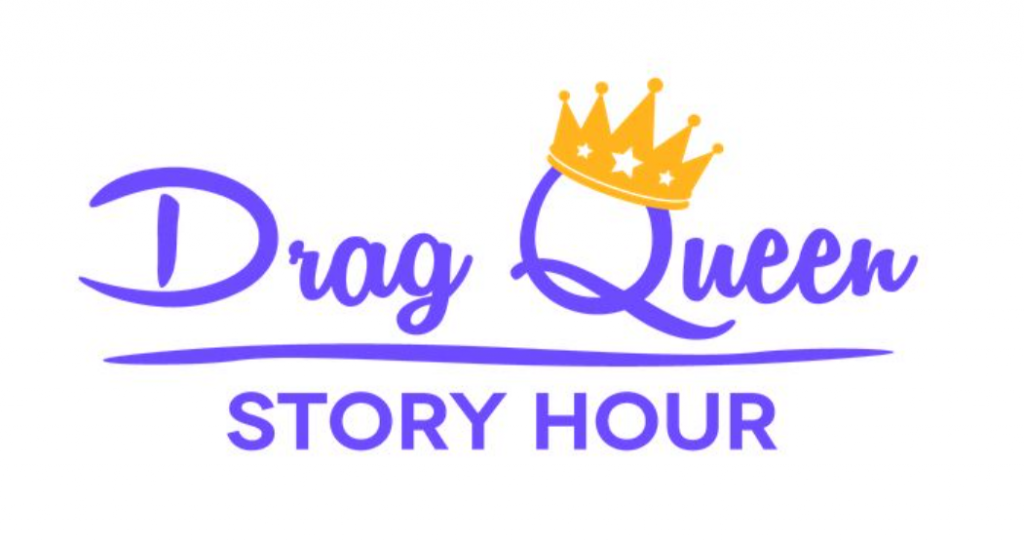
Is drag then now considered mainstream? That depends on whom you ask, because with drag’s growth in popularity has come a dangerous backlash against how and where this art form is practiced. Author Michelle Tea, then the executive director of the nonprofit Radar Productions, created in San Francisco in 2015 the first Drag Story Hour geared for children. Her goals were to promote reading and diversity. Various versions of the event have popped up all over the country since then.
In recent years, protests against these events have become more frequent, and threatening. Some protestors have arrived bearing arms. Still others have stormed events and hurled verbal abuse against the drag artists and event organizers. Some have threatened to kill the drag hosts. Just a few days ago in Manhattan, protestors against Drag Story Hour were confronted by a man hoping to stave off the threats, but he then allegedly got into a tussle with a police officer monitoring the demonstration. A flurry of expletives followed and then the man’s arrest. The Drag Story Hour event had to be shut down early.

In June, members of the extremist group Proud Boys disrupted a similar happening in San Lorenzo, CA. The event was hosted by well-known local drag queen Panda Dulce. In an Instagram post, Dulce wrote, “No words can appropriately capture the immediacy and terror u feel when u realize there is no buffer between u and these men. That they are likely armed and you are utterly defenseless.” Dulce managed to ease the situation before the police arrived, preventing it from escalating.
Drag as an art form clearly has not lost any of its power to elicit emotions. Whether drag has always been political, or got pulled into politics, it is now center stage as an act of rebellion against gender and other norms. Drag’s ever-growing fame has brought with it a powerful platform that has yet to be fully realized.
Published on December 15, 2022
Recent Comments